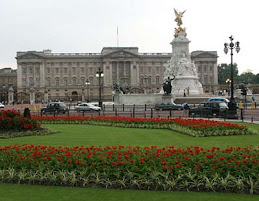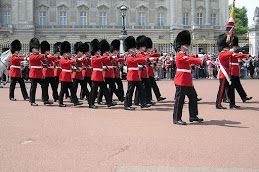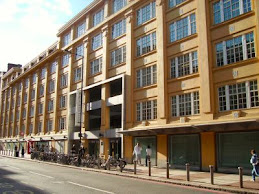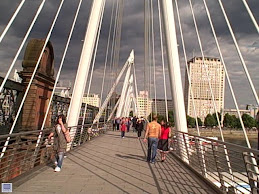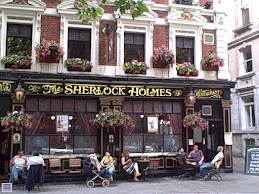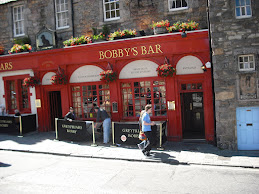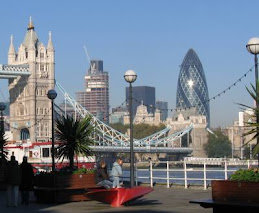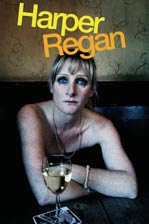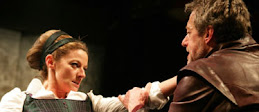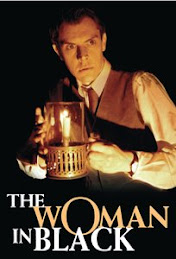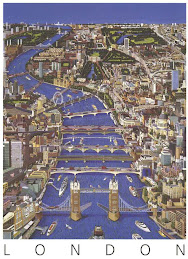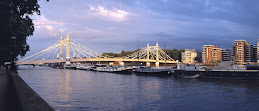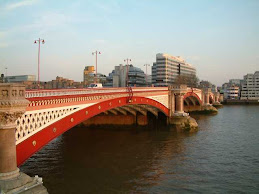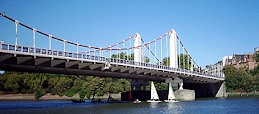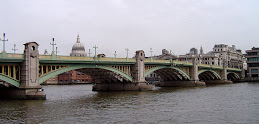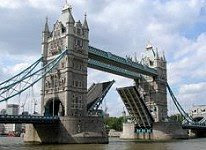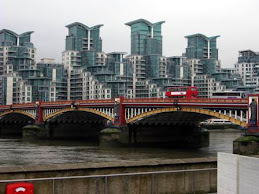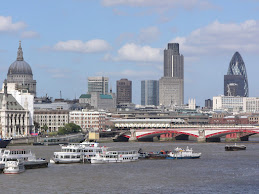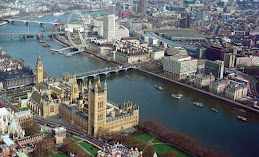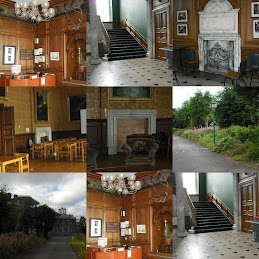
Week Two: Tour of the Museum of London
I would have to dub this day the prettiest one we have had in London! The skies were blue and there was a light wind swirling around that was very comfortable for the walk about London. The morning was perfect for a stroll towards the Museum of London. By now, the class as a whole is maneuvering around London with much more ease and feeling quite a bit more confident in our travels on the Tube to wherever our destination may be. Arriving at the Museum, somewhere very near to the Barbican Lending Library toured last week, it was obvious that the building was modern and I wondered to myself about the type of historical collections and displays that we would view. The group was lead into a room to meet our tour guide and it was apparent that there was going to be a private introduction before touring the collection.

Meet Jon Cotton, Senior Curator:
Mr. Jon Cotton, the Senior Curator over pre-history at the museum showed the class a slideshow put together in order to offer us a bit of an understanding of the gallery through a description of the thinking that underlies the gallery. He informed us that this gallery is the “London Before London Gallery” (450,000 BC – c. AD 50).
Background History of the Museum:
In the 1960’s and 1970’s, the prior Museum of London building was bursting at the seams, so a newer and larger building was in order to offer ample spacing to grow and spread out. A newer building was a need and Mr. Cotton stated that the museum “aimed to be a one-time stop shop" where the main collection of London history would be housed. I learned that the Museum is one part of two institutions: (1.) The Guildhall Museum; and the (2.) London Museum. The Guildhall Museum originated in the 1920’s and deals with the city of London. The London museum is a private institution and originated in 1911. Both of these organizations came together in the 1970’s at the current site. Mr. Cotton stated that London libraries are statutory, yet museums are not, so there may be some existing tensions.
In the year of 2000, the museum came into its second site. Jon went on to discuss the story of London as a Roman port. Out of interest, he stepped ahead in London time to also mention a famous London story and display of Jack the Ripper to tell the story of London in the 1880’s. He mentioned how this gruesome display offered photos of the victims and mortuary in London.
The third site of the Museum of London (LAARC) houses the archeological archives of London with over 5,000 site records of primary data such as drawings, records, and information on the great fire of 1666. This site is the oldest of the three sites, with reference to the collection.
Marketing the Prehistoric London Collection:
The Museum of London is the world’s largest urban history museum. Jon explained that the urbanism aspect of this library is to send out the message to “come and visit us.” Urban is to a settlement as in Roman times. Our tour guide said that in his work he deals with everything prior to the Roman times, so it is interesting to him that he deals with the archeological archives of London with this collection.
Visitor Patrons/Demographics:
The majority of the patrons who come to visit the Museum of London are foreign tourists, mostly English. The numbers of Londoners attending the museum though, are steadily increasing. Approximately 40,000 visitors attend each year, with 50% being Londoners and school children, about 10% are British non-tourists, and 40% are tourists. When thinking of what people love to see when they come to London, Jon mentioned things dealing with Victorian Life and Roman Life. He then proceeded to show us an image of the Rose Theater, the precursor to the Globe Theater which burned down. The Rose Theater can today be found and is preserved in the basement of an office block! The present Globe can be found immediately around the corner. :)
Key Thoughts on when Pre-history begins and what it deals with:
Mr. Cotton then discussed ‘pre-history’ conceptions by many patrons and when asked for initial responses of what prehistory means to them, he typically discovers that people think dinosaurs for one response fit that category. Yet, the Museum of London does not cover the period when dinosaurs existed, but the time before written records, before Romans arrived. Mr. Cotton confirmed what I had already assumed that prehistory is relative to where one is in the world.
Two key thoughts our tour guide told us to keep in mind as we go through the museum is to think of pre-historic as “people”. He analogy of the television personality Ray Miess who survives the wild and trains others in survival techniques is who we were instructed to think of when we think of prehistory in terms of the collection at the Museum of London. The items in the collection reveal people as individuals who are adaptable in response to environmental elements for one. These are the kind of people that are reflected in the collection.
The Landscape of the Collection and what it May Reveal:
In 1998, the former director wanted to do a display on the changing faces and bodies of prehistoric and modern Londoners. Some examples of the collection dated back to 3,000 BC. One item was a pot found in the Thames River. The pot itself gives ideas of man from the hand decor, as there were holes, thumbprints and pinch marks used to decorate it. A mold of the hole in the pot was made and revealed the finger of what was thought to be a woman, as women did this sort of work. It was thought that it was her pinky or index finger because it was slender. There were some preconceptions that were amazingly made of man from this time period due to the discovery of one little pot with hand decor. This is the nature of the work of finding out the secrets of man through self discovery in located objects in London. Mr. Cotton astutely stated that the landscape can move or effect us and offer the power of place. A prime example is Stonehenge which evokes many feelings in us. Seahenge was another remarkable piece of landscape, with a circule of ancient (early bronze age) timbers projecting from the sands North of Norfolk, that still generates “heat, interest, and feeling” as does the collection at the Museum of London. Seahinge was excavated and is a very remote and special or sacred area. Interestingly, there is quite a bit of conflict that revolves around the excavation at Seahenge, as the locals want the archaeologists to leave it alone so that it may decay naturally over time.
The Thames River: How it ties into the Collection and the Building
The Thames River is a major London landscape feature. It is a sacred River that runs North and south of the region. Mr. Cotton stated it is odd how the behaviour and segregation of the London Northerners and Southerners is so unique and distinctive that even today (as it was historically) some cabbies will never cross the boundaries!
There have been many gifts that the River Thames has given to London. Many objects have been thrown in the River long ago or been buried, such as Hindu objects that was thrown in expression of a sacred ritual or offering to the River. The river has always been important to the region and is used basically today in the same manner as it was in prehistory. It was then that I recognized a theme ongoing with the museum. The River Thames is truely the core of the collection, as it tells a story of man that brings us from the prehistoric time to today. It is for this reason that I think the new building is reflected in an urban or modern building and displays. The old and the new are tied together by the River Thames. The River Thames is centered in the building with the landscape surrounding it like an envelope. The materials used in the gallery are of new materials that encase the historical objects. The gallery is truely a union of the prehistory and modern times and was quite beautiful! Mr. Cotton stated that the River Thames acts as a central focus of activity. This theme carried over in the gallery.
Following through the slideshow in the orientation and a description of the new gallery in 2002, we learned that the gallery was given an art gallery retail approach, which is a ‘radical’ departure from common London museums. The new and larger space offered an area to nicely spread out the collection and not place important items in corridors, as so commonly found in other museums and art galleries. We learned about the four key messages found in this gallery:
1. Climate
2. River
3. People
4. Legacy
Surely, man was a product of his climate as life revolved around it and the River was a great resource for thriving. Our guide saw “people as more than surviving but thriving.” In relevance to the legacy of prehistoric man, he had his own language and his own way of doing things (man as a term to include Women!).
The outlay of the Museum of London and its prehistory collection is of straight lines and displays. The three landscape elements of the building tell an old story on the edges of the walls with poems, quotes and informational signage (that offered more condensed information than in the past). The three elements included the River, Landscape and Archeology. The wooden displays were of ethnic oak. The idea was to look to spirituality for inspiration of the spaces. The quotes and poems in the displays promote ‘reaction’. Jon said that they want people to learn and remember!
Inside the Gallery:

The common thread of the collection is the River Thames and natural sound effects carried one through the collection. There was a great display of flint tools throughout that dated back as far as 450,000 BC. The collection was one that lead you through chronologically in time and told a story!
The Museum of London is one that has been transforming over the years and is in an exciting period of revealing all of its new and interactive exhibits that chart London’s changes. The gallery is evolving as I write this and will reflect so much more in the future, to offer an even more inspirational and diverse collection that engages Londoners and other visitors. It was just amazing to explore London as it may have been a half million years ago, when animals, hunters and farmers roamed the London landscape. A journey that takes you into an unstable time is what the Museum of London offers and tells one about the many changes of a landscape brought about by natural and human forces and how man adapted to it in his community. The Riverwall, the Landscape Wall, and the Wooden Plinths all offer displays and messages to carry back with you. It is a story of how the land was shaped with climatic and sea level influences on the landscape and people. What resulted were communities that appeared where people carved out homes and utilized the resources found within. Patterns of habitation emerged as there were obvious climate and social tensions.
The tour offered an avenue into the past as one wondered how much we have changed over time. The 5,000 year old Shepperton Woman whose bones were discovered was reconstructed to offer a way to see how Londoners may have looked in comparison to people of today. A historical Account of the Great Fire in 1666, that I wish I could have spent more time perusing, offered another way to see how Londoners dealt with the tragedy and further shaped society. Romans also greatly influenced London and left its permanent marks on a city that can be seen even today. More interactive displays to be completed in 2009, will explore in more detail how Medieval and Victorian Londoners and the city is ever evolving. The Museum of London is a must see and one to learn about the city through stories, text, photographs, video and sounds to promote an emotional response!

Weblinks of Relevance:
Museum of London
Stonehenge
Seahenge
River Thames: History
